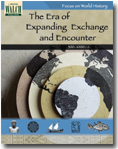This series of four books serves as a supplement to world history studies for grades 7-12, although I suspect they will be most useful at the high school level. You might use one or more volumes during a school year depending upon the time span of your studies. Also, activities from these books might be used selectively. You need not complete all of them.
The four volumes and their time periods are:
The Era of Early Civilizations and Empires (3.5 million years ago to the 300s C.E.)
The Era of Expanding Exchange and Encounter (300-1000 C.E.)
The Era of Expanding Global Connections (1000-1500 C.E.)
The Era of the First Global Age and Revolution (1450-1900 C.E.)
Each book is self-contained with teacher material, student material, and answer key. There are six or seven units within each book. Teacher material at the beginning of each unit briefly summarizes the key ideas of the unit and then describes each of the student activities. Activities in this series often involve reading and completing reproducible worksheets with questions, charts, maps, etc. (Every volume includes some map work.) Most activities will require outside research, written responses, a hands-on activity such as the creation of a graph, presentation of a speech, or participation in a discussion. Optional "Extra Challenge" suggestions follow some activities. These generally require even more research and might direct a student to do an oral or written presentation, roleplay, or create a visual display. The teacher material makes it easy to select activities since they are all briefly summarized at the beginning of the unit.
As you might surmise from the time period designations, this is a decidedly secular series that supports an evolutionary viewpoint. While it deals with religions, Christians are likely to find this series decidedly lacking in understanding or appreciation of Christianity. For example, p. 100 of the third book is titled "The Great Schism" but it conflates the title "Great Schism" (which is commonly applied to the split between the Roman Catholic Church and the Orthodox Church) with both the "Western Schism" (a period when the Papacy moved from Rome to Avignon and when there were sometimes simultaneous claimants to the title of Pope) and the Protestant Reformation. Also, Christianity and Western Civilization get scant attention in the second book. It devotes one of six units to the growth and spread of world religions. The next unit focuses solely on the rise of Islamic civilization. Bearing in mind that this covers the years 300-1000 C.E. (or A.D.) it would seem critical to have a reasonable portion of activities address Western Civilization, but the author has chosen instead to concentrate on Asia, Africa, and the Americas. Still, these books are meant as supplements rather than primary texts so this might actually be a positive thing if a student's primary textbook is almost exclusively focused on Western Civilization as some tend to be. These books might bring a larger perspective and presentation of alternate viewpoints that could be valuable.
In addition to maps, charts, and other worksheets, within each unit are pages of background information that are to be copied and given to students since they don't have a textbook. (Yes, this does mean you will need to do quite a bit of photocopying, but you will only need the one book for your family or for a group class.)
The amount of information students read from these pages is relatively small. Students will have to use other sources for their research. Lists of some suggested resources at the back of each volume include website addresses.
One thing I particularly like about this series is that the questions and activities are thought-provoking. It presents a variety of viewpoints and pushes students to think beyond the obvious, look for cause and effect, analyze information, and generally go deeper than is required in most history courses. And because much of this happens through a variety of activities rather than the same type of activity each time, it should be engaging for most students.
In the back of the book, following the answer key information for each unit, there are additional activity suggestions that I would highly recommend for high school students. Following these extra suggestions are assessment questions. These might be used for essay writing or oral discussion (a great alternative for those who have difficulty writing).
The books were written for classroom use, so there are sometimes activities that suggest or even require a larger group. If you don't have enough children in your family, you might adapt or skip those activities, or you might consider working with another family or two to create a group class.












